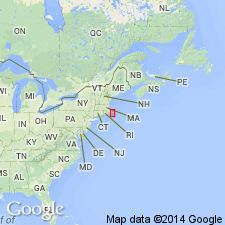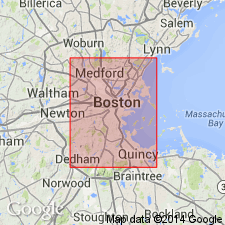
- Usage in publication:
-
- Rice Gneiss
- Modifications:
-
- Not used
- AAPG geologic province:
-
- New England province
Summary:
Not used on MA State bedrock geologic map. [No explanation given. Still good usage.]
Source: GNU records (USGS DDS-6; Reston GNULEX).

- Usage in publication:
-
- Rice Gneiss
- Modifications:
-
- Not used
- AAPG geologic province:
-
- New England province
Summary:
Not used on MA State bedrock geologic map of Zen and others (1983). Included as part of their unnamed unit of metamorphosed mafic to felsic flow, volcaniclastic, and hypabyssal intrusive rocks. [No explanation given. Name is not abandoned. Chapters A-J in U.S. Geological Survey Professional Paper 1366 are intended as explanations and (or) revisions to 1:250,000-scale MA State bedrock geologic map of Zen and others (1983).]
Source: GNU records (USGS DDS-6; Reston GNULEX).

- Usage in publication:
-
- Rice Blastomylonite
- Modifications:
-
- Redescribed
- AAPG geologic province:
-
- New England province
Summary:
Rice Gneiss was renamed Rice Blastomylonitic Gneiss by Grimes (1993: Boston College, M.S. thesis). At Rice Road and Rte 30 (the type locality) unit is a quartz-rich foliated quartz-biotite-muscovite-feldspar mylonite with lenticles of amphibolite and a pronounced foliation, which contains schistose amphibolite, veins of granitic material and blocks of Westboro Quartzite. Veins of granite or aplite related to the Dedham Granite crosscut the foliation. Westward the gneiss passes laterally into a migmatitic fragmental rock, interpreted by these authors as the remobilized Rice Blastomylonite.
Source: GNU records (USGS DDS-6; Reston GNULEX).
For more information, please contact Nancy Stamm, Geologic Names Committee Secretary.
Asterisk (*) indicates published by U.S. Geological Survey authors.
"No current usage" (†) implies that a name has been abandoned or has fallen into disuse. Former usage and, if known, replacement name given in parentheses ( ).
Slash (/) indicates name conflicts with nomenclatural guidelines (CSN, 1933; ACSN, 1961, 1970; NACSN, 1983, 2005, 2021). May be explained within brackets ([ ]).

